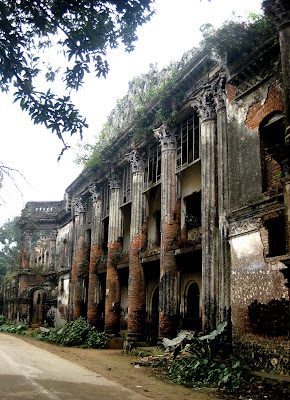
So transient is the glory of the world!
The poet Shelley expressed the emotion far better than I could! "Look on my works ye mighty, and despair! Nothing beside remains."
Near Noagoan, the ruins of Dubalhati palace suggest how Buckingham Palace might appear had the Luftwaffe achieved their aim. The magnificent, lengthy classical façade is almost all that remains of what, clearly, was once a magnificent home.
It is a glorious monument to the great wealth of Zaminders. Even where much of the interior has collapsed into piles of rubble, sufficient pillared colonnades remain to remind the visitors of classical Greece or Rome.
In the case of this stately mansion, the name ‘palace’ may well be appropriate. And perhaps the British royal crest on the pediment of one wing enhances the truly royal illusion.

Wandering through the arches, and over the rubble or across the courtyard in which, today, youths play badminton where once the family and visitors once took their leisure, entertained by musicians and actors whose residences still stand outside arouses extraordinary emotions including exultation and dismay.


North of Noagoan, Balihar Palace appears to be another, perhaps older, story of decline and decay. A Mughal style building, constructed perhaps in the early 19th century, although perhaps even earlier seems, together with affine Hindu temple that has not been enhanced by the addition of a tin roofed, concrete verandah, to be all that remains of an original larger palace that locals say was largely destroyed in the 1897 Earthquake. Certainly, a large stone stairway leading nowhere might suggest a considerable earlier house.

The classical gateway, and the large Adam style late 19th century mansion behind the older one certainly betoken different times of development.
The buildings, despite some fine friezes, are clearly decaying, with only a ground floor room of the larger house being used as a library by a nearby college.
A home of some interest to the architectural student. Whilst mentioning the decline and decay of what was once the heartland of the Raj, it would be remiss not to mention yet another, humbler remain of the age of the zaminders.
In many ways the most characterful of any such places is the zaminderbari near Gaibanda. The corrugated iron roof of an old bungalow may mislead. In the gardens behind the bungalow, and the compound in which the last zaminder’s family still live, stands the decaying remains of a magnificent Mughal period shrine with intricate and beautiful stonework. Beside the bungalow there stands a small Hindu Temple of the same period, once again with fine stonework.
The last zaminder was also an actor and singer, and regularly put on performances for the village people beneath the porch of his bungalow.
It is doubtful if similar entertainment was on offer at all zaminderbari!

No comments:
Post a Comment